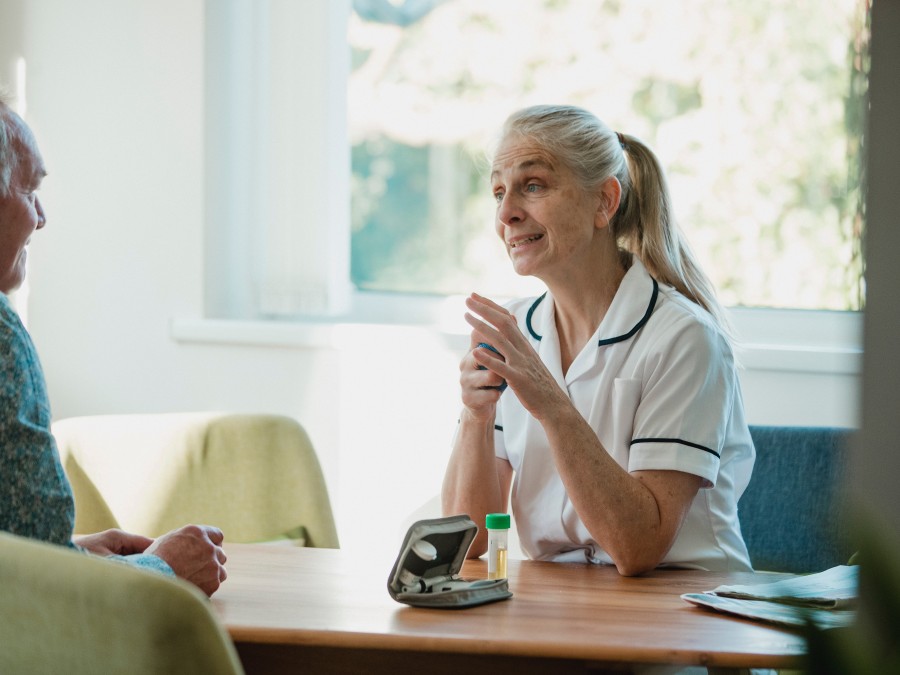Hyperglycaemia treatment

If you have been diagnosed with diabetes, you may have heard of hyperglycaemia — high blood glucose (sugar) [1].
You may have learned about the causes and symptoms of hyperglycaemia, and your diabetes healthcare team will have shown you how to check your blood glucose levels.
This article will look at how you can treat hyperglycaemia once you have recognised it, situations where you might need some extra help, and how to reduce the chance of high blood glucose.
Diagnosing hyperglycaemia
Before you can treat hyperglycaemia, it’s important to recognise the signs that your blood glucose might be high. You may not get the same set of signs as someone else, so understanding what a hyperglycaemic episode feels like to you is really valuable.
Notice the signs
The first step to detecting hyperglycaemia is noticing the signs that you get when your blood glucose is high.
The signs of hyperglycaemia can include [1, 2]:
- Being extremely thirsty
- Urinating a lot
- Feeling very tired and fatigued
As hyperglycaemia progresses and becomes more severe, there can also be changes to your mental state, you can feel lethargic, and you may have trouble with your vision and concentration [1, 2].
There is also a risk of diabetic ketoacidosis (DKA) and if you have this condition you may also feel nauseous or vomit, feel pain in your abdomen, or have rapid breathing [1, 2, 3]. DKA is very serious and you should seek medical attention straight away.
Check your blood glucose
The next step if you suspect a hyper is to test your blood glucose levels straight away.
Many people use a handheld glucose meter to check a small sample of their blood by a small finger prick and use a blood glucose strip inside the glucose meter to test it [4]. This is known as ‘capillary blood glucose monitoring’ or capillary BGM. Your healthcare team will explain the process to you, as frequent blood glucose monitoring will help guide you in diabetes management, such as deciding what insulin dose to administer and food intake [4].
Some people may use continuous glucose monitoring (CGM) to measure their glucose levels too [4]. CGM devices measure glucose levels in the interstitial fluid (the fluid which surrounds the fatty tissue) via a sensor, and come in two forms [4]. One type of CGM will give you a continuous read of your blood glucose via receiver, mobile app, smartwatch or insulin pump — and may have alarms to alert you if you are going out of range [4]. The second type of CGM tells you what your blood glucose is when the CGM transmitter is scanned by a reader or smartphone [4].
Another method of measuring blood glucose is the HbA1c test [4]. Your healthcare team may have talked to you about this test, or you may have had blood taken for it when having a diabetes checkup. The HbA1c test does not measure blood glucose in the same way as the other daily methods — it is used to evaluate your long-term glucose management [2, 4]. Your HbA1c is a measure of what your average blood glucose levels have been like over the last three months [4]. Unlike the blood glucose meter and the continuous glucose monitor, it cannot tell you what your BG levels are at the present moment [4].
Hyperglycaemia treatment
For people with type 1 diabetes, episodes of hyperglycaemia can be common [2]. They can occur for a number of reasons, such as not administering enough insulin (if you miss a dose or administer the wrong amount of insulin for your carb intake, for example [2]). Other things can lead to high blood glucose too, such as stress, illness or intensive exercise [2].
Although this can be frustrating, it helps to understand your body and what you can do to help or prevent it [2].
How to lower blood glucose when you have type 1 diabetes
Your healthcare team will discuss your own individual targets and you will have a target range to try and maintain [5]. When you go out of range and have high blood glucose , you will need to treat with insulin [2].
When you are administering insulin, there are two types of doses you can give — basal and bolus [6].
The basal dose provides your baseline insulin needs throughout the day and night [6]. If you use an insulin pump, then your basal dose will be a slow-acting insulin that the pump administers all the time [6].
Another type of dose is called a bolus dose [6]. The bolus dose is what you might administer to manage changes in your blood glucose caused by eating, exercise or illness [6]. It can also be used to reduce your blood glucose if it is out of range[6]. If you are using an insulin pump, the bolus can be administered by a one-time dose from your pump of rapid acting insulin [6].
Treating a hyper episode
If you are having a ‘hyper’ — hyperglycaemic episode — one of the first things you should do is administer insulin [2].
Your GP or diabetes team will explain your ‘correction factor’ to you — the amount of insulin you will need to lower your blood glucose with, depending on the circumstances [2].
It’s important not to administer too many doses of insulin, as this can lead to hypoglycaemia — low blood glucose. It’s worth remembering that insulin can take 20 to 30 minutes to work and can continue to have an effect for 4 to 5 hours [2].
While having a hyper episode, you should try to keep yourself hydrated with water or other carb-free drinks [2].
What to do after having a hyperglycaemic episode
After having had high blood glucose, you might need to take a few steps to look after yourself afterwards too.
To ensure that you have treated your high blood glucose successfully, you should try to check your blood glucose more often than you usually would to monitor your range [5].
Keep yourself nourished and hydrated as best you can and take the time to rest if you need it.
As always, if you have any concerns about your blood glucose levels, the dose of insulin, or the type of insulin that you are taking, you should discuss them with your diabetes team.
Emergency treatment of hyperglycaemia
There are two major emergencies that are associated with high blood glucose — diabetic ketoacidosis (DKA) and hyperglycaemic hyperosmolar state (HHS) [7].
In both conditions, you have high blood glucose and dehydration [7]. The management of both conditions will involve similar treatments, although they may be given at different rates or times [7]
If you are unwell, having trouble getting back into your target range and/or have a high ketone count, you should seek medical assistance as soon as you can.
How to prevent hyperglycaemia
If you have had repeated episodes of high blood glucose, you might want to discuss with your healthcare team about ways to keep your blood glucose in range. They will be happy to advise you and give you tips and resources to help you stay on track [5].

Studies have shown that people who maintain their target range [8]:
- Check their blood glucose more often
- Rarely miss their insulin doses
- Administer bolus doses before a meal rather than during or after
- Exercise more frequently
If you are having difficulties with measuring your blood glucose, speak to your healthcare team about the most suitable method for checking your glucose levels and don’t be afraid to ask questions if you would like to clarify what you know and how to do it [9].
Hyperglycaemia, or high blood glucose, can lead to short-term and long-term complications [6, 7]. Over time, you can learn to recognise the early signs of hyperglycaemia and understand when you need to treat it [1].
By understanding your blood glucose targets, and with the help of your healthcare team, there are steps that you can take to manage hyperglycaemia and reduce the chances of high blood glucose [5, 6].
Sources
- Mouri M, Badireddy, M. Hyperglycaemia. StatPearls. Treasure Island (FL): StatPearls Publishing; 2022 Jan. Available from: https://www.ncbi.nlm.nih.gov/books/NBK430900/
- JDRF. Type 1 Diabetes High Blood Sugar Symptoms: Hyperglycemia Symptoms. Accessed August 2022. Available at: https://www.jdrf.org/t1d-resources/about/symptoms/blood-sugar/high/
- Trachtenbarg, D. E. Diabetic Ketoacidosis. American Family Physician; 2005, 71(9): 1705-1714.
- Holt, RIG et al. The Management of Type 1 Diabetes in Adults. A Consensus Report by the American Diabetes Association (ADA) and the European Association for the Study of Diabetes (EASD). Diabetes Care. 2021; 44 (11): 2589–2625.
- Centers for Disease Control and Prevention (CDC). Manage Blood Sugar. Accessed April 2022. Available at: https://www.cdc.gov/diabetes/managing/manage-blood-sugar.html.
- Cooke, DW, Plotnick, L. Type 1 diabetes mellitus in pediatrics. Pediatr. Rev. 2008; 29: 374-385.
- Dhatariya, K. Blood Ketones: Measurement, Interpretation, Limitations, and Utility in the Management of Diabetic Ketoacidosis. The review of diabetic studies. 2016;13(4):217-225. doi:10.1900/RDS.2016.13.217.
- Simmons, JH et al. Differences in the Management of Type 1 Diabetes Among Adults Under Excellent Control Compared With Those Under Poor Control in the T1D Exchange Clinic Registry. Diabetes Care. 2013; 36 (11): 3573–3577.
- Deiss, D. et al. Improved Glycemic Control in Poorly Controlled Patients with Type 1 Diabetes Using Real-Time Continuous Glucose Monitoring. Diabetes Care. 2006; 29 (12): 2730–2732.



